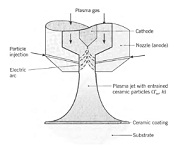Discuss the below in detail:
Q: Plasma spray-coating processes are often used to provide surface protection for materials exposed to hostile environments, which induce degradation through factors such as wear, corrosion, or outright thermal failure. Ceramic coatings are commonly used for this purpose. By injecting ceramic powder through the nozzle (anode) of a plasma torch, the particles are entrained by the plasma jet, within which they are then accelerated and heated.
During their time-in-flight the ceramic particles must be heated to their melting point and experience complete conversion to the liquid state. The coating is formed as the molten droplets impinge (sp/at) on the substrate material and experience rapid solidification. Consider conditions for which spherical alumina (AI2O3) particles of diameter Dp = 50µm, density Pp = 3970 kg/m3, thermal conductivity kp = 10.5 W/m · K, and specific heat cp = 1560 J/kg · K are injected into an arc plasma, which is at T8, = 10,000 K and provides a coefficient of h = 30,000 W/m2 · K for convective heating of the particles. The melting point and latent heat of fusion of alumina are Tmp = 2318 K and hsf = 3577 kJ/kg, respectively.
(a) Neglecting radiation, obtain an expression for the time-in-flight, tj - f, required to heat a particle from its initial temperature T j to its melting point T mp and, once at the melting point, for the particle to experience complete melting. Evaluate ti - f for Tj = 300 K and the prescribed heating conditions.
(b) Assuming alumina to have an emissivity of sp = 0.4 and the particles to exchange radiation with large surroundings at Tsur = 300 K, assess the validity of neglecting radiation
